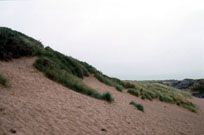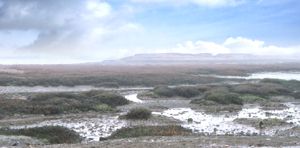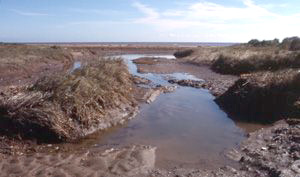Sand dunes and dune slacks
 Sand dunes often contain a good deal of lime (in the form of fragments of broken seashells) essential for the formation of gastropod shells, but the habitat is usually very dry, which is not congenial to the the majority of snails. However, some species of Mediterranean origin are very much at home in such conditions, so it is not surprising that some of the species found in sand dunes are accidental introductions.
Sand dunes often contain a good deal of lime (in the form of fragments of broken seashells) essential for the formation of gastropod shells, but the habitat is usually very dry, which is not congenial to the the majority of snails. However, some species of Mediterranean origin are very much at home in such conditions, so it is not surprising that some of the species found in sand dunes are accidental introductions.
Some of the species usually associated with calcareous grassland are also found in sand dunes, as are species which are at the northern limit of their distribution, but which can take advantage of the moderating effect of coastal conditions.
Dune slacks are the hollows between the dune ridges, which remain moist for much of the year and for part of the year may have standing water. These may contain species of more general distibution.
Associated species
- Candidula gigaxii - Scarce; southern; an introduced species
- Candidula intersecta - Common; widespread; an introduced species.
- Cernuella virgata - Common; an introduced species.
- Cepaea nemoralis - Common; widespread; of general distribution but tends to favour stabilised sand dunes towards the northern limits of its distribution.
- Cepaea hortensis - Common; widespread; of general distribution but tends to favour stabilised sand dunes towards the northern limits of its distribution.
- Cochlicella acuta - Frequent; almost exclusively maritime in Britain, but does occur inland in southern Ireland
- Cochlicella barbara - Rare; introduced; restricted to a few sites on south coast and South Wales.
- Cornu aspersum - Common; widespread; of general distribution but tends to favour sand dunes towards the northern limits of its distribution.
- Monacha cantiana - Common; widespread; of general distribution but tends to favour sand dunes towards the northern limits of its distribution.
- Monacha cartusiana - A very rare introduced species; restricted to SE.
- Pupilla muscorum - Frequent; a very typical species of short calcareous grassland. Like Helicella itala, it has got rarer as grass has got longer.
- Theba pisana pisana - Scarce, but locally abundant; introduced; restricted to coastal parts of South Wales, Cornwall and Channel Islands
- Trochoidea elegans - A very rare introduced species; restricted to SE.
- Vallonia costata - Common; this is a more tolerant species than V. excentrica (below), and can be found also in dry, open woodland.
- Vallonia cf. excentrica / pulchella - Common; the first of these is the form found in dry grassland; the latter tends to occur in wetter open places. There is some doubt as to whether these are two species, or just ecological variants.
- Vertigo pygmaea - Frequent
Saltmarsh
 Areas of mud and small pools associated with rivers and estuaries and colonised with many species of plant (e.g. sea purslane, Atriplex) and green algae (e.g. Vaucheria). Species which may be found include:–
Areas of mud and small pools associated with rivers and estuaries and colonised with many species of plant (e.g. sea purslane, Atriplex) and green algae (e.g. Vaucheria). Species which may be found include:–
Associated species
- Assiminea grayana (in south-east and east)
- Peringia ulvae
- Littorina saxatilis
- Myosotella myosotis
- Alderia modesta
- Limopontia depressa
Dykes and drainage ditches
 Bodies of water with a salinity ranging from 5 to 35 parts per thousand of chloride. The species found are determined by the salinity.
Bodies of water with a salinity ranging from 5 to 35 parts per thousand of chloride. The species found are determined by the salinity.
Associated species
- Potamopyrgus antipodarum
- Peringia ulvae
- Hydrobia acuta neglecta
- Ventrosia ventrosa
- Littorina saxatilis
- Onoba aculeus
- Lepidochitona cinereus
- Akera bullata
- Haminoea naviculata
- Cerastoderma glaucum
- Abra tenuis
